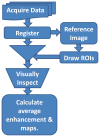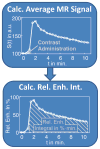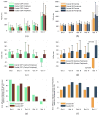Changes in perfusion and diffusion in the endplate regions of degenerating intervertebral discs: a DCE-MRI study
- PMID: 26238936
- PMCID: PMC4755697
- DOI: 10.1007/s00586-015-4172-y
Changes in perfusion and diffusion in the endplate regions of degenerating intervertebral discs: a DCE-MRI study
Abstract
Purpose: Dynamic contrast-enhanced MRI (DCE-MRI) was used to investigate the associations between intervertebral disc degeneration and changes in perfusion and diffusion in the disc endplates.
Methods: 56 participants underwent MRI scans. Changes in DCE-MRI signal enhancement in the endplate regions were analyzed. Also, a group template was generated for the endplates and enhancement maps were registered to this template for group analysis.
Results: DCE-MRI enhancement changed significantly in cranial endplates with increased degeneration. A similar trend was observed for caudal endplates, but it was not significant. Group-averaged enhancement maps revealed major changes in spatial distribution of endplate perfusion and diffusion with increasing disc degeneration especially in peripheral endplate regions.
Conclusions: Increased enhancement in the endplate regions of degenerating discs might be an indication of ongoing damage in these tissues. Therefore, DCE-MRI could aid in understanding the pathophysiology of disc degeneration. Moreover, it could be used in the planning of novel treatments such as stem cell therapy.
Keywords: Dynamic contrast-enhanced magnetic resonance imaging; Intervertebral disc degeneration; Intervertebral disc endplate; Lumbar spine.
Figures







References
-
- Luoma K, Riihimäki H, Luukkonen R, et al. Low back pain in relation to lumbar disc degeneration. Spine. 2000;25:487–492. - PubMed
Publication types
MeSH terms
Substances
Grants and funding
LinkOut - more resources
Full Text Sources
Other Literature Sources

